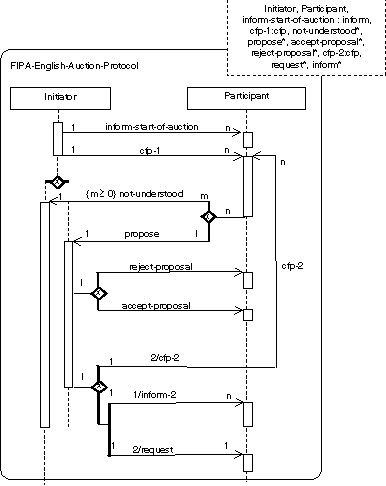1 FIPA English Auction Interaction Protocol
In the FIPA English Auction Interaction Protocol (IP), the auctioneer seeks to find the market price of a good by initially proposing a price below that of the supposed market value and then gradually raising the price. Each time the price is announced, the auctioneer waits to see if any buyers will signal their willingness to pay the proposed price. As soon as one buyer indicates that it will accept the price, the auctioneer issues a new call for bids with an incremented price. The auction continues until no buyers are prepared to pay the proposed price, at which point the auction ends. If the last price that was accepted by a buyer exceeds the auctioneer's (privately known) reservation price, the good is sold to that buyer for the agreed price. If the last accepted price is less than the reservation price, the good is not sold
In Figure 1, the auctioneer's calls, expressed as the general cfp act (see [FIPA00037]), are multicast to all participants in the auction. For simplicity, only one instance of the message is portrayed. Note also that in a physical auction, the presence of the auction participants in one room effectively means that each acceptance of a bid is simultaneously broadcast to all participants and not just the auctioneer. This may not be true in an agent marketplace, in which case it is possible for more than one agent to attempt to bid for the suggested price. Even though the auction will continue for as long as there is at least one bidder, the agents will need to know whether their bid (represented by the propose act - see [FIPA00037]) has been accepted. Hence the appearance in the IP of the accept-proposal (see [FIPA00037]) and reject-proposal acts (see [FIPA00037]), despite this being implicit in the English Auction process that is being modelled.
Note that the proposals that are submitted by the bidders primarily concern the bidding process. In response to a cfp to submit bids to purchase a good X, a proposal would be something of the order: “I propose that the bidding level be raised to purchase price Z and I assert that I am able to pay Z for X.” This allows the auctioneer to be confident that the bidder can indeed pay the price without committing to actually paying it until the auctioneer specifically requests X (at price Z) from the winning bidder.
At the end of the IP, the auctioneer will typically enter a request IP (see [FIPA00026]) with the winning bidder to complete the auction transaction.
The representation of this IP is given in Figure 1.

Figure 1: FIPA English Auction Interaction Protocol
1.1 Exceptions to Interaction Protocol Flow
This IP is a pattern for a simple interaction type. Elaboration on this pattern will almost certainly be necessary in order to specify all cases that might occur in an actual agent interaction. Real world issues of cancelling actions, asynchrony, abnormal or unexpected IP termination, nested IPs, and the like, are explicitly not addressed here.
2 References
[FIPA00026] FIPA Request Interaction Protocol
Specification. Foundation for Intelligent Physical Agents, 2000.
http://www.fipa.org/specs/fipa00026/
[FIPA00037] FIPA Communicative Act Library Specification.
Foundation for Intelligent Physical Agents, 2000.
http://www.fipa.org/specs/fipa00037/